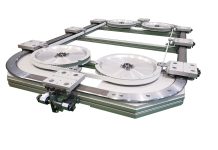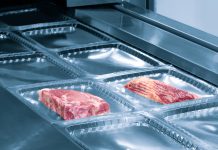 The demand for spun paste cheese is still growing especially for products such as mozzarella and pizza cheese. In America and Europe spun paste production has outperformed many local cheese. Pasta filata, “spun paste” in Italian, is a cheese type also known as stretched-curd, pulled-curd, and plastic-curd cheese. It usually comes from water buffalo milk, cow milk and goat milk individually or mixed. This kind of cheese have in common the process called filatura (melting and stretching). The curds are steeped for some hours in a bath of very hot whey, or salted water up to 95°C. This results in curd “plasticizing” that gives the finished cheese its characteristic fibrous structure, along with melting and stretching properties. The curd mass is aftermath divided (often by pulling out a thick strand and chopping it) and shaped into individual cheese molds. The discover that heating the curd with hot water results in making it stretchable dates back to the Middle Age. This procedure unconsciously and unintentionally selected the thermophillic bacteria removing most of the viable mesophillic. The Pasta Filata cheese is classified into two main categories: hard cheese such as Caciocavallo, Provolone, the mexican Oaxaca and Palmito; and soft, moist cheese such as Mozzarella, Provole, Scamorze.
The demand for spun paste cheese is still growing especially for products such as mozzarella and pizza cheese. In America and Europe spun paste production has outperformed many local cheese. Pasta filata, “spun paste” in Italian, is a cheese type also known as stretched-curd, pulled-curd, and plastic-curd cheese. It usually comes from water buffalo milk, cow milk and goat milk individually or mixed. This kind of cheese have in common the process called filatura (melting and stretching). The curds are steeped for some hours in a bath of very hot whey, or salted water up to 95°C. This results in curd “plasticizing” that gives the finished cheese its characteristic fibrous structure, along with melting and stretching properties. The curd mass is aftermath divided (often by pulling out a thick strand and chopping it) and shaped into individual cheese molds. The discover that heating the curd with hot water results in making it stretchable dates back to the Middle Age. This procedure unconsciously and unintentionally selected the thermophillic bacteria removing most of the viable mesophillic. The Pasta Filata cheese is classified into two main categories: hard cheese such as Caciocavallo, Provolone, the mexican Oaxaca and Palmito; and soft, moist cheese such as Mozzarella, Provole, Scamorze.
THE PROCESS
In the industrial process, the spun paste cheese making is a combination of milk acidification, heat, enzymes addition and mechanical actions. The production starts from a milk stabilization with an heat treatment; virtually all spun paste cheese is made from pasteurized milk these days. The heat treatment destroys unwanted bacteria, spores and bacteriophages and the acidification speeds up the whole process. The milk is then cooled to a temperature suitable for starter growth. In order to reach quickly the correct pH, citric acid can be added at this stage.
Inoculation
Cheese cultures are used to acidify the milk. There are several varieties of cultures which react differently with milk to adjust the pH; In spun paste cheese process, bacterial starter of S. thermophilus and a high-temperature-growing Lactobacillus are used. The starter cultures influence the functional characteristics, such as paste stretching. A great choice of thermophilic cultures with strong phage-resistant properties is on the market. The cultures are pure or in blends of Streptococcus thermophilus, Lactobacillus delbrueckii ssp. Bulgaricus. In order to improve galactose fermentation, Lactobacillus helveticus may be added. The amount of lactic acid produced at this stage and the moisture level will increase the paste melting and the stretching.
react differently with milk to adjust the pH; In spun paste cheese process, bacterial starter of S. thermophilus and a high-temperature-growing Lactobacillus are used. The starter cultures influence the functional characteristics, such as paste stretching. A great choice of thermophilic cultures with strong phage-resistant properties is on the market. The cultures are pure or in blends of Streptococcus thermophilus, Lactobacillus delbrueckii ssp. Bulgaricus. In order to improve galactose fermentation, Lactobacillus helveticus may be added. The amount of lactic acid produced at this stage and the moisture level will increase the paste melting and the stretching.
Curdling
Rennet is added at the temperature of 34-38°C. in order to coagulate milk proteins. There are animal and vegetable rennets available. They can be liquid, tablet, paste or in powder; liquid calf rennet is the first choice for pasta filata cheese. Rennet contains of a proteolytic enzyme (protease) that coagulates the milk, causing it to separate into solids and whey. The main enzymatic action in rennet comes from chymosin but also pepsin and lipase affect the final result in terms of texture and flavor. Also vegetable rennet can be used to meet need of vegetarian consumers and to curb costs. It is made from the thistle family of plants or from a mold (Mucor Miehei). Late proteolysis by residual rennet should be avoided as it would affect casein molecules and decrease stretch attitude.
Cutting the curd
During the clotting process the micelles form aggregates. After coagulation and cutting, individual curd particles begin to shrink, losing serum in response to stirring, heating and acid development. The type of cut and the timing varies with the kind of cheese to be produced.
Acidification
The cut curds are kept at warm temperature (30-38°C.) up to 8 hours for further acidification. Acidification boosts the release of whey and controls undesirable bacteria growth. In this stage the curd has to reach pH 5,0-5,4.
Melting and stretching
 Acidified curds are stirred with hot water 58-66°C. causing them to melt together. The fluid mass of cheese is then shaped and eventually plunged into cool water. The melt and stretch properties of cheese are based on many different interactions between casein molecules. The loss in calcium phosphate from the casein improves the necessary rearrangement of the casein molecules. The fewer are the bound of calcium phosphate, and more the casein molecules are able to rearrange. Stretch (often called “knead”) is the result of interplay between casein molecules rearranged. In order to understand how cheese can stretch is necessary to go back to all the changes the milk undergone until this stage and figure the casein behaviour when conditions during the process change. In general there is an increase in melt and stretch as the pH decreases. At pH close to 6,6-6,7 the main interactions between casein molecules involve calcium phosphate. As the pH decreases, there is a loss in calcium phosphate from the casein that is replaced by hydrogen as H+. Micelles begin to merge only if the casein molecules can rearrange and form new associations with other casein molecules; this occurs at pH 4,7-5,2 however, the actual pH at which cheese actual begins to acquire melt or stretch proprieties, or lose them, depends on casein content and bounds of calcium phosphate. If the pH drops too low, the casein molecules begin to “disconnect” and reorganize into aggregates and the stretch characteristics can be lost. At a low pH (<4,6), there are too few contacts or interactions between the masses to allow stretch. Cheese higher in fat content may require a higher bound calcium content (higher pH) to maintain stretch and desired melting and vice versa for lower fat cheeses. During melting process part of milk fat is released.
Acidified curds are stirred with hot water 58-66°C. causing them to melt together. The fluid mass of cheese is then shaped and eventually plunged into cool water. The melt and stretch properties of cheese are based on many different interactions between casein molecules. The loss in calcium phosphate from the casein improves the necessary rearrangement of the casein molecules. The fewer are the bound of calcium phosphate, and more the casein molecules are able to rearrange. Stretch (often called “knead”) is the result of interplay between casein molecules rearranged. In order to understand how cheese can stretch is necessary to go back to all the changes the milk undergone until this stage and figure the casein behaviour when conditions during the process change. In general there is an increase in melt and stretch as the pH decreases. At pH close to 6,6-6,7 the main interactions between casein molecules involve calcium phosphate. As the pH decreases, there is a loss in calcium phosphate from the casein that is replaced by hydrogen as H+. Micelles begin to merge only if the casein molecules can rearrange and form new associations with other casein molecules; this occurs at pH 4,7-5,2 however, the actual pH at which cheese actual begins to acquire melt or stretch proprieties, or lose them, depends on casein content and bounds of calcium phosphate. If the pH drops too low, the casein molecules begin to “disconnect” and reorganize into aggregates and the stretch characteristics can be lost. At a low pH (<4,6), there are too few contacts or interactions between the masses to allow stretch. Cheese higher in fat content may require a higher bound calcium content (higher pH) to maintain stretch and desired melting and vice versa for lower fat cheeses. During melting process part of milk fat is released.
Molding and brining
The soft curd mass is kneaded into balls or blocks, cooled and placed in brine for a very short time. It’s not predictable a sudden temperature change when the cheese is put in brine as it causes irregular gradients of moisture from center to surface. In the case of mozzarella or fior di latte, the process is now essentially complete. For other cheese such as Provolone, Caciocavallo Silano, Pallone di Gravina and Scamorza, further processing is needed: ageing and in some cases longer brining and/or smoking.
Aging
At first, aging involves the “buffering” phase which imply displacing bound calcium with H+ and the casein hydration. The second phase is a slow proteolysis, it may have an effect on melt or stretch when extended for several weeks.
Pasta-Filata Cheese industrial manufacturing
The spun paste cheese is a traditional product, and it is still widely manufactured by hand in small dairies. In industrial process, extensive technology replaced the original pure handicraft, improving the hygienic quality and increasing productivity. The industrial handling of milk before the acidification stage is not very different to many other cheese. After the acidification phase, the curd is milled and turned to homogeneous strand-dough-like cheese. During this process the “ strand“ is cut into small pieces; they are then passed in a auger conveyor while immersed in hot water to a rubbery texture consistency as it arrives at the end of the conveyor. The stretching and melting are worked by special machines by means of rotating arms. After the stretching process, the cheese mass is moulded. A moving spiral belt presses the cheese mass into forms, typically ball shaped. The balls are then chilled by plunging them in cold water or sprayed with iced water. The cheese balls are eventually soaked into a saline bath ready for the packaging lines. More advanced application uses microfilters to strain out the soluble milk proteins prior to cheesemaking. The result is Mozzarella-style cheese with zero loss of valuable dairy whey proteins.



